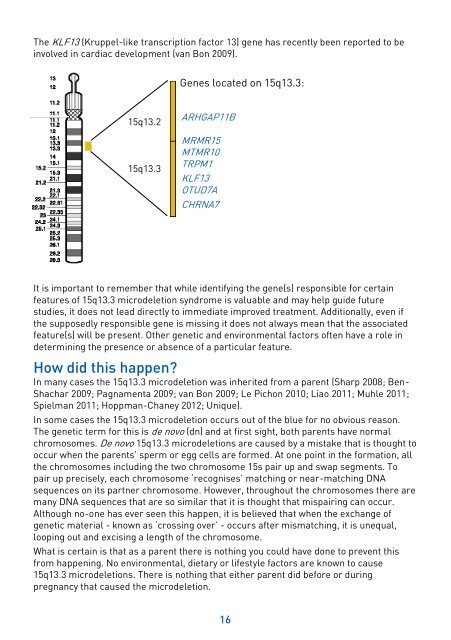15q13.3 microdeletion syndrome - Unique - The Rare Chromosome ...
15q13.3 microdeletion syndrome - Unique - The Rare Chromosome ...
15q13.3 microdeletion syndrome - Unique - The Rare Chromosome ...
Create successful ePaper yourself
Turn your PDF publications into a flip-book with our unique Google optimized e-Paper software.
<strong>The</strong> KLF13 (Kruppel-like transcription factor 13) gene has recently been reported to be<br />
involved in cardiac development (van Bon 2009).<br />
Genes located on <strong>15q13.3</strong>:<br />
15q13.2<br />
<strong>15q13.3</strong><br />
ARHGAP11B<br />
MRMR15<br />
MTMR10<br />
TRPM1<br />
KLF13<br />
OTUD7A<br />
CHRNA7<br />
It is important to remember that while identifying the gene(s) responsible for certain<br />
features of <strong>15q13.3</strong> <strong>microdeletion</strong> <strong>syndrome</strong> is valuable and may help guide future<br />
studies, it does not lead directly to immediate improved treatment. Additionally, even if<br />
the supposedly responsible gene is missing it does not always mean that the associated<br />
feature(s) will be present. Other genetic and environmental factors often have a role in<br />
determining the presence or absence of a particular feature.<br />
How did this happen?<br />
In many cases the <strong>15q13.3</strong> <strong>microdeletion</strong> was inherited from a parent (Sharp 2008; Ben-<br />
Shachar 2009; Pagnamenta 2009; van Bon 2009; Le Pichon 2010; Liao 2011; Muhle 2011;<br />
Spielman 2011; Hoppman-Chaney 2012; <strong>Unique</strong>).<br />
In some cases the <strong>15q13.3</strong> <strong>microdeletion</strong> occurs out of the blue for no obvious reason.<br />
<strong>The</strong> genetic term for this is de novo (dn) and at first sight, both parents have normal<br />
chromosomes. De novo <strong>15q13.3</strong> <strong>microdeletion</strong>s are caused by a mistake that is thought to<br />
occur when the parents’ sperm or egg cells are formed. At one point in the formation, all<br />
the chromosomes including the two chromosome 15s pair up and swap segments. To<br />
pair up precisely, each chromosome ‘recognises’ matching or near-matching DNA<br />
sequences on its partner chromosome. However, throughout the chromosomes there are<br />
many DNA sequences that are so similar that it is thought that mispairing can occur.<br />
Although no-one has ever seen this happen, it is believed that when the exchange of<br />
genetic material - known as ‘crossing over’ - occurs after mismatching, it is unequal,<br />
looping out and excising a length of the chromosome.<br />
What is certain is that as a parent there is nothing you could have done to prevent this<br />
from happening. No environmental, dietary or lifestyle factors are known to cause<br />
<strong>15q13.3</strong> <strong>microdeletion</strong>s. <strong>The</strong>re is nothing that either parent did before or during<br />
pregnancy that caused the <strong>microdeletion</strong>.<br />
16

















